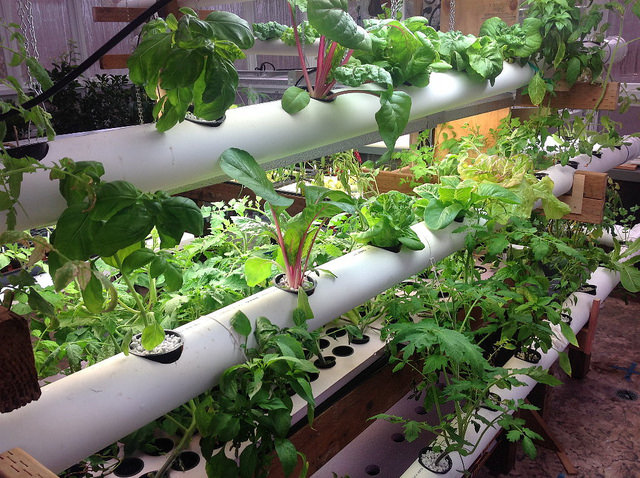Nutrient Film Technique, continued
This is page 5 in our twelve page series on nutrient film technique. Click any of the below pages to jump to that page.
Page 1 Page 2 Page 3 Page 4 Page 5 Page 6 Page 7 Page 8 Page 9 Page 10 Page 11 Page 12

A variety of crops can be grown in NFT systems. Here's just a sampling. Notice that the various plant spacing distances correspond to the mature size of the plant, and varies between the lower front channel, the upper central channel, and the densely planted sheet in the background. The sheet in the background may be either another NFT system or possibly a raft system. The principle is the same: give the plants as much room as they'll need at maturity.
Which Crops Work In Nutrient Film Technique?
Ideal NFT crops are those which meet the following criteria:
1.
Small to medium-sized individual plants which
have an individual, upright growing habit (some draping or spreading is OK if there is sufficient space between plants in a channel, and/or between channels).
2. Plants which are seeded, transplanted and harvested individually rather than grown in clumps or mats.
3. If the plant droops (or the fruit droops off the plant), it can still be grown in NFT as long as you’ve allowed sufficient space for the fruits between NFT channels.
4. Shallow rooted plants, and those with multiple small roots rather than a single major taproot
5. Annuals or biennial plants. The only reason this on the list is because perennial plants, even small ones, eventually develop such heavy matted roots that they clog the NFT channels.
6. Plants which do not get too tall or top-heavy. Since the plants have relatively little anchoring in the NFT channel, taller plants run the risk of tipping over as they grow.
Lettuces, arugula, endive, corn salad, and other small leaved salad greens are the primary plants grown in nutrient film technique systems. Some leafy herbs are also grown, though not as commonly. Strawberries are becoming a more common NFT crop since soil-based strawberry plantings are so vulnerable to fungal infections, and methyl bromide was phased out for conventional production. In this scenario, the strawberries can be planted, grown, allowed to produce daughter plants, then removed from the system before disease issues become an issue. Then the channels and net pots are sterilized and the next generation is planted.Some plants which would not normally be considered good candidates can be planted successfully in nutrient film technique systems, as long as some caveats are followed. Crops with an indeterminate vining growth habit, such as tomatoes and summer or winter squash, can be rooted in NFT channels. Their vines and fruits will need a sturdy trellising system not only to keep them off the ground but also to provide easy access to the NFT channels for maintenance purposes. These plants have the capacity to grow for several years but are often retired prior to that, to ensure their massive root systems don’t clog the NFT channels.
While this website is dedicated to edible plants, NFT certainly isn't limited to crops. A wide variety of decorative plants, flowers, houseplants, medicinals and even brambles, fruiting bushes and small trees can be grown in NFT systems. As long as the various design caveats are followed, the NFT system in principle can be adapted to grow a wide variety of diverse plants.
One of the most exciting parts of hydroponics in general, and certainly NFT in particular, is that we've only started to scratch the surface of what's possible. if you have a particular crop in mind that you'd like to try in NFT, by all means try it! Design an nutrient film technique system which will work with the plant's natural growing habit, and try to either optimize how NFT can help that plant reach maturity as efficiently as possible, while also meeting your needs for plant access, irrigation, maintenance, crop rotation, etc. Thanks to the internet we can share our successes (and our failures). So if you do experiment, share your results!
Back Next
Click any of the below links to jump to that page.
Page 1 Page 2 Page 3 Page 4 Page 5 Page 6 Page 7 Page 8 Page 9 Page 10 Page 11 Page 12